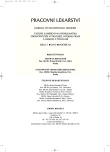Effect of concentration on transdermal absorption of pyrene in vitro
Authors:
L. Kotingová 1; V. Voříšek 2; Eva Čermáková 3; L. Borská 4; Z. Fiala 1
Authors‘ workplace:
Ústav hygieny a preventivního lékařství, Univerzita Karlova v Praze, Lékařská fakulta v Hradci Králové, přednostka doc. MUDr. Jindra Šmejkalová, CSc.
1; Ústav klinické biochemie a diagnostiky, Fakultní nemocnice Hradec Králové, přednosta prof. MUDr. Vladimír Palička, CSc.
2; Oddělení výpočetní techniky, Univerzita Karlova v Praze, Lékařská fakulta v Hradci Králové, vedením pověřený Ing. Jiří Špulák
3; Ústav patologické fyziologie, Univerzita Karlova v Praze, Lékařská fakulta v Hradci Králové, přednosta prof. MUDr. Miroslav Kuba, DrSc.
4
Published in:
Pracov. Lék., 64, 2012, No. 1, s. 18-22.
Category:
Original Papers
Overview
The objective of the experiment was to determine the effect of pyrene concentration on transdermal absorption in vitro. A static 10 ml diffusion chamber was used for the testing with absorption area of 1.77 cm2. The skin of the pig posterior side of auricle formed the penetration membrane. Three donor concentrations of pyrene (0.00095 and 0.0095 and 0.095 g pyrene/g acetone) were tested. The receptor fluid was composed from the Hank’s solution, bovine serum albumin and gentamicin and was sampled in the intervals of 12, 24, 48 and 72h. The samples were analyzed by means of gas capillary chromatography connected with mass spectrometer. The pyrene concentration in the receptor fluid increased with the time of exposure, but differences between individual concentrations used were never statistically significant. The lag time values were the only significant differences observed (p = 0.047; α = 0.05).
Key words:
skin – in vitro absorption – pyrene – polycyclic aromatic hydrocarbons
Sources
1. BENSON, H. A. Transdermal drug delivery: penetration enhancement techniques. Curr. Drug. Deliv., 2005, 2, 1, s. 23–33.
2. BOSETTI, C., BOFFETTA, P., LA VECCHIA, C. Occupational exposures to polycyclic aromatic hydrocarbons, and respiratory and urinary tract cancers: a quantitative review to 2005. Ann. Oncol., 2007, 18, 3, s. 431–446.
3. BOFFETTA, P., JOURENKOVA, N., GUSTAVSSON, P. Cancer risk from occupational and environmental exposure to polycyclic aromatic hydrocarbons. Cancer Causes Control., 1997, 8, 3, s. 444–472.
4. BORSKÁ, L., ANDRÝS, C., KREJSEK, J., HAMÁKOVÁ, K., KREMLÁČEK, J., RANNÁ, D., KOTINGOVÁ, L., FIALA, Z. Plasma levels of p53 protein and chromosomal aberrations in patients with psoriasis treated with the Goeckerman regiment. Clin. Exp. Dermatol., 2009, 34, 8, s. e881–883.
5. BOS, J. D., MEINARDI, M. M. The 500 Dalton rule for the skin penetration of chemical compounds and drugs. Exp. Dermatol., 2000, 9 (3), s. 165–169.
6. BRANDT, H. C., WATSON, W. P. Monitoring human occupational and environmental exposures to polycyclic aromatic compounds. Ann. Occup. Hyg., 2003, 47 (5), s. 349–378.
7. DAVIES, D. J., WARD, R. J., HEYLINGS, J. R. Multi-species assessment of electrical resistance as a skin integrity marker for in vitro percutaneous absorption studies. Toxicol. In Vitro, 2004, 18 (3), s. 351–358.
8. ELMAHJOUBI, E., FRUM, Y., ECCLESTON, G. M., WILKINSON, S. C., MEIDAN V. M. Transepidermal water loss for probing full-thickness skin barrier function: correlation with tritiated water flux, sensitivity to punctures and diverse surfactant exposures. Toxicol. In Vitro, 2009, 23 (7), s. 1429–1435.
9. EU-SCCP: Basic criteria for the in vitro assessment of dermal absorption of cosmetic ingredients. Brusel, 2006.
10. FIALA, Z., VYSKOČIL, A., KRAJÁK, V., MAŠÍN, V., EMMINGER, S., SRB, V., TEJRAL, J. Polycyklické aromatické uhlovodíky I. Kontaminace prostředí a expozice osob. Acta Medica Suppl., 1999, 42, s. 77–89.
11. FRANZ, T. J. Percutaneous absorption on the relevance of in vitro data. J. Invest. Dermatol., 1975, 64 (3), s. 190–195.
12. HADGRAFT, J. Skin deep. Eur. J. Pharm. Biopharm., 2004, 58, 2, s. 291–299.
13. OECD: Guidance document for the conduct of skin absorption studies. OECD Environmental Health and Safety Publications, Series on Testing and Assessment No. 28. Paris, 2004.
14. OECD: Guideline for testing of chemicals – Guideline 428: Skin absorption: In vitro method. Paris, 2004.
15. ROOS, P. H., BOLT H, M. Cytochrome P450 interactions in human cancers: new aspects considering CYP1B1. Expert. Opin. Drug. Metab. Toxicol., 2005, 1, 2, s. 187–202.
16. VANROOIJ, J. G., BODELIER-BADE, M. M., JONGENEELEN, F. J. Estimation of individual dermal and respiratory uptake of polycyclic aromatic hydrocarbons in 12 coke oven workers. Br. J. Ind. Med., 1993, 50, 7, s. 623–632.
17. WALTER, D., KNECHT, U. Standardized investigation of percutaneous absorption of bitumen emission in humans. J. Occup. Environ. Hyg., 2007, 4, S1, s. 144–153.
18. WHO: Environmental Health Criteria 235 – Dermal Absorption. Ženeva: WHO Press, 2006.
18. WILLIAMS, A. C. Transdermal and topic drug delivery. Londýn: Pharmaceutical Press, 2003, 242 s.
Labels
Hygiene and epidemiology Hyperbaric medicine Occupational medicineArticle was published in
Occupational Medicine

2012 Issue 1
Most read in this issue
- Diseases of locomotor apparatus of upper extremities in a female officer loading data in the computer
- Effect of hyperbaric oxygenotherapy on nonhealing defects
- The problem of drug use in occupational medical care
- Extrinsic allergic alveolitis – a case report
